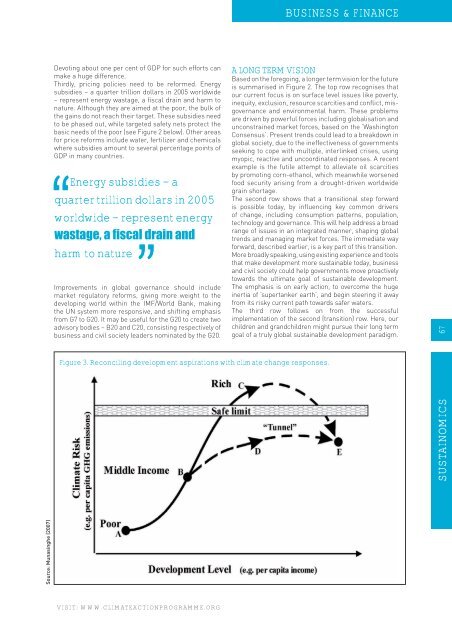Climate Action 2009-2010
You also want an ePaper? Increase the reach of your titles
YUMPU automatically turns print PDFs into web optimized ePapers that Google loves.
BUSINESS & FINANCE<br />
Devoting about one per cent of GDP for such efforts can<br />
make a huge difference.<br />
Thirdly, pricing policies need to be reformed. Energy<br />
subsidies – a quarter trillion dollars in 2005 worldwide<br />
– represent energy wastage, a fiscal drain and harm to<br />
nature. Although they are aimed at the poor, the bulk of<br />
the gains do not reach their target. These subsidies need<br />
to be phased out, while targeted safety nets protect the<br />
basic needs of the poor (see Figure 2 below). Other areas<br />
for price reforms include water, fertilizer and chemicals<br />
where subsidies amount to several percentage points of<br />
GDP in many countries.<br />
“<br />
Energy subsidies – a<br />
quarter trillion dollars in 2005<br />
worldwide – represent energy<br />
wastage, a fiscal drain and<br />
harm to nature<br />
“<br />
Improvements in global governance should include<br />
market regulatory reforms, giving more weight to the<br />
developing world within the IMF/World Bank, making<br />
the UN system more responsive, and shifting emphasis<br />
from G7 to G20. It may be useful for the G20 to create two<br />
advisory bodies – B20 and C20, consisting respectively of<br />
business and civil society leaders nominated by the G20.<br />
A LONG TERM VISION<br />
Based on the foregoing, a longer term vision for the future<br />
is summarised in Figure 2. The top row recognises that<br />
our current focus is on surface level issues like poverty,<br />
inequity, exclusion, resource scarcities and conflict, misgovernance<br />
and environmental harm. These problems<br />
are driven by powerful forces including globalisation and<br />
unconstrained market forces, based on the ‘Washington<br />
Consensus’. Present trends could lead to a breakdown in<br />
global society, due to the ineffectiveness of governments<br />
seeking to cope with multiple, interlinked crises, using<br />
myopic, reactive and uncoordinated responses. A recent<br />
example is the futile attempt to alleviate oil scarcities<br />
by promoting corn-ethanol, which meanwhile worsened<br />
food security arising from a drought-driven worldwide<br />
grain shortage.<br />
The second row shows that a transitional step forward<br />
is possible today, by influencing key common drivers<br />
of change, including consumption patterns, population,<br />
technology and governance. This will help address a broad<br />
range of issues in an integrated manner, shaping global<br />
trends and managing market forces. The immediate way<br />
forward, described earlier, is a key part of this transition.<br />
More broadly speaking, using existing experience and tools<br />
that make development more sustainable today, business<br />
and civil society could help governments move proactively<br />
towards the ultimate goal of sustainable development.<br />
The emphasis is on early action, to overcome the huge<br />
inertia of ’supertanker earth’, and begin steering it away<br />
from its risky current path towards safer waters.<br />
The third row follows on from the successful<br />
implementation of the second (transition) row. Here, our<br />
children and grandchildren might pursue their long term<br />
goal of a truly global sustainable development paradigm.<br />
Figure 3. Reconciling development aspirations with climate change responses.<br />
Source: Munasinghe (2007)<br />
SUSTAINOMICS 67<br />
VISIT: WWW.CLIMATEACTIONPROGRAMME.ORG












